Research Article Open Access
Male Breast Cancer in Fiji - A Descriptive Study
| Singh S1*, Nagra S2 and Cama J. Mr3 | ||
| 1 Medical Officer and National Acting Epidemiologist, Ministry of Health-Fiji | ||
| 2 Surgical Registrar, Colonial War Memorial Hospital (CWMH), Suva | ||
| 3 Senior Lecturer/Consultant Paediatric Surgeon, Fiji School of Medicine/CWMH | ||
| Corresponding Author : | Dr. Sheetal Singh Medical Officer and National Acting Epidemiologist Ministry of Health-Fiji Tel: 679-3306177 E-mail: sheetal@nagras.com |
|
| Received October 16, 2011; Accepted February 01, 2012; Published February 04, 2012 | ||
| Citation: Singh S, Nagra S, Cama JMr (2012) Male Breast Cancer in Fiji – A Descriptive Study. Autacoids S6:001. doi: 10.4172/2161-0479.S6-001 | ||
| Copyright: © 2011 Singh S, et al. This is an open-access article distributed under the terms of the Creative Commons Attribution License, which permits unrestricted use, distribution, and reproduction in any medium, provided the original author and source are credited. | ||
Related article at Pubmed Pubmed  Scholar Google Scholar Google |
||
Visit for more related articles at Journal of Autacoids and Hormones
Abstract
Objective: To describe the trends in epidemiology of adult male breast cancer in Fiji and compare with international trends Study design: Population based descriptive study of retrospective data over an 11 year period. Methodology: Secondary data from Fiji’s cancer card registry was analysed from 2000-2010 to describe trends of male breast cancer. Results and discussion: Male breast Cancer (MBC) accounts for approximately 2% of all breast cancers in Fiji over the past 11 years, which is twice the proportion from global trends of 1%. The median age of diagnosis (59 years) in our study group was 7 years younger than that reported internationally. However, as with international studies,the most susceptible age groups for MBC in Fiji are the 65-69 age groups. Adenocarcinomas, especially ductal carcinoma was the most common histological type seen with the majority being moderate to poorly differentiated cancer. Due to the poor record keeping and the unavailability of a centralized cancer registry, the outcomes of these patients were not available. It is evident that more awareness is required to encourage earlier presentation.
| Keywords | |
| Male breast cancer; Ductal carcinoma | |
| Abbreviations | |
| Male Breast Cancer (MBC); Surveillance Epidemiology; End Results Registry (SEER) This paper was presented in the combine Pacific Medical Association (PMA) and Fiji Medical Association (FMA) Conference held in Denarau, Fiji on 18th-20th August 2011. | |
| Introduction | |
| Globally the incidence of Male Breast Cancer is about 1 per 100,000 populations, with higher rates in North America and Europe and lower rates in Asia [1]. In some African countries such as Uganda, Egypt and Morrocco much higher rates have been found. Male breast cancer (MBC) is a rare diagnosis and is often diagnosed late and therefore has a poor outcome. Other factors that contribute to its poor outcome include the small size of male breasts, the lack of awareness that males can also develop breast cancer and the poor health seeking behaviour of male patients. Various international studies have indicated a need to increase awareness of the disease to encourage earlier presentation [2-5]. As in females, MBC is treatable with very good outcomes if detected and treated early. No data is currently available in the South Pacific including Fiji on MBC and this is a problem that needs to be addressed. | |
| Methods | |
| The Fiji Cancer Card Registry, which are manual records of all cancer patients at the Health Information Unit of the Ministry of Health, was used to identify all cases of MBC from 2000 to 2010. Hence, all male cases among whom the cancer site was labelled as ‘breast’ were selected for notification of details. These details included patient demographics, hospital number (NHN), location, date of diagnosis and tissue diagnosis, which were tabulated on an excel spreadsheet for analysis. All cancer card records were accompanied by pathology reports (either results from cytology or histology specimens), which were used as means of verification of the cases identified. For those manual records where the NHN were provided, data was correlated with the Patient Information System (PATIS). Likewise, death certificates were used to verify those who had died from MBC. The total numbers of cases identified through the manual records were compared against the number that was reported in the electronic database to ensure that all cases had been captured. The descriptive analysis of the identified cases included analysis of distribution by age, histology and grading. In addition, the proportion of male breast cancer among all breast cancers was calculated. | |
| Results | |
| A total of 19 cases of male breast cancer (MBC) were diagnosed in Fiji over the past 11 years from January 2000 to December 2010 and therefore averaging 2 new cases of MBC per annum. | |
| Of these 19 cases, majority (17 cases) were adenocarcinomas. Most of these were invasive ductal carcinomas (7 cases). Of these 7 ductal carcinomas, 3 were papillary carcinomas and the remaining 4 were not specified (Figure 1 above). The remaining 10 cases of adenocarcinomas were histologically not specified as either ductal or lobular. There was one case of squamous carcinoma reported and one patient out of the 19 cases had a histological type which was not specified. In Fiji, over the past 11 years, among the 37% of cases where the grading was mentioned, 14% were well differentiated, 57% moderately well differentiated and 29% poorly differentiated i.e. 86% in grade II and III as per the Scarff- Bloom-Richardson grading. | |
| The incidence of male breast cancer is ranging from 0.23 to 1.27 per 100,000 of the male population in Fiji [6]. | |
| When comparing the occurrence of breast cancer between males and females in Fiji, it was found that the proportion of male breast cancer among all breast cancers ranges between 1 and 7%, which on average is about 2% per year over the past 11 years. | |
| The age distribution of the cases in Fiji range from as young as 40 years to those in the seventh decade at 79 years. Hence, the mean age at the time of diagnosis in our population was at 58 years and a median age of diagnosis of 59 years. | |
| Although we did not formally come across any case of lobular carcinoma in our case series, there is a small chance that some of the non-specific adenocarcinomas in the 53% category could have been lobular. In our study, only one case of hormone receptor expression was reported. Likewise, only one case of squamous cell breast carcinoma was reported in 2000. | |
| Discussion | |
| Review of principal findings | |
| The trend of male breast cancer in Fiji appears twice as high as global statistics (2.18% of all breast cancers per annum) with a median age of diagnosis about 7 years earlier than that reported globally. Ductal Adenocarcinoma is the most common histological type with the most susceptible age groups between 65-69 years, which is similar to world reports. Majority of MBC cases in Fiji present late with histological grading of II and III. | |
| In Fiji, the incidence of MBC is similar to that of international trends such as the United States of America (about 1.06 per 100,000) [1]. Majority of the cases (5) in Fiji were diagnosed in 2005 when the Ministry of Health (MOH) took a different approach in preventing NCDs where government budgetary allocation alongside donor funding had been increased [7]. These measures included more public awareness and outreach clinics which perhaps increased the diagnosis of male breast cancer. | |
| There are several studies which suggest that there is an increase in the number of male breast cancer with higher rates in North America and Europe and lower rates in Asia [1,8]. However, some studies also indicate stable trends in Europe [8]. Various reasons have been reported such as the trend of an aging population [9]. Therefore, the most susceptible age groups are men in their sixth and seventh decade [10]. However, it is important to note that, there have been some case reports in the world literatures of elderly patients being diagnosed as late as 93years of life. These are in contrast to those children diagnosed as young as 5 years who have different tumour pathologies as compared to adults [11]. | |
| The median age of diagnosis in Fiji was 7 years younger when compared to international trends between 65 - 67 years [12]. In comparison, the median age of diagnosis of female breast cancer in Fiji over the past 11 years is 52 This is also about 9 years younger compared to international trends such as USA where the median age of diagnosis among females is about 61years. At present we have not ascertained an explanation as to why the Fijian population are prone to have breast cancer at an early age. However, this may be due to underreporting of cases in the older age groups for both males and females. The life expectancy at birth in Fiji is about 69, which is lower than some of the Pacific Island countries in the region such as Samoa and Tonga (72) as well as the more developed countries such as USA (79) and United Kingdom (80). Therefore, deaths of the Fijian population from other diseases such as cardiovascular disease and diabetes at an earlier age, may reduce diagnosis of cancer. Nevertheless majority of cases were still diagnosed at the 65 - 69 age groups among males and this was comparable to the international trend. | |
| As with international trends, our study has shown a predominance of adenocarcinomas, especially ductal [10]. The Surveillance Epidemiology and End Results Registry (SEER) of 2900 MBC, showed that 93.7% of male breast cancers are ductal, 2.6% are papillary, 1.8% are mucinous and 1.5% lobular [9]. Similarly, in a population based study in the USA, of the 282 males, there were no cases of lobular or medullary carcinoma [13]. Generally, Lobular carcinoma among males accounts for merely 1 to 2% as compared to 10-15% among females [14]. This is due to the lack of terminal lobules in male breasts [14]. | |
| MBC have high rates of hormone receptor expression with about 90% expressing estrogen receptor and about 80% expressing progesterone receptor [3]. We could not establish a reason for the poor hormone receptor expression in Fiji apart from the possibility of unspecified reporting. The single case of squamous cell breast carcinoma reported in 2000 in Fiji was unusual as primary squamous cell carcinoma comprises of <0.5% of all male and female breast cancers [15]. | |
| The proportion of MBC among all breast cancers in Fiji is double the global trends of 1% [16]. MBC is uncommon as the worldwide incidence suggests women are approximately 100 times more likely of getting breast cancer than men [17]. However, in Fiji, the proportion was on average 2% over the past 11 years. Apart from the possibility that men in Fiji are at a higher risk of MBC, we may be under diagnosing female breast cancer. For example, the higher percentages of male breast cancer cases (as in 2005), raises the question of whether female breast cancer were also underreported during these periods and this is a concern. | |
| Strengths and limitations | |
| By referring to just over a decade of data on MBC in Fiji enabled demonstration of trends for drawing conclusions. The existence of electronic records of total numbers of breast cancer cases provided a means of verification of the MBC cases identified. However, unfortunately, records of individual patients were difficult to obtain and therefore the study was severely hindered in terms of individual patient records and outcomes. | |
| Implications of the study and future research | |
| Fiji is expected to report about 800 to 1,600 new cases of cancer per year based on trends estimated in developing countries [18]. However, over the past 15 years (1995-2009) based on the Cancer Registry in Fiji, only about 500 cases of cancer are reported annually, suggesting some degree of under reporting or patients failure to seek medical attention. As a result, this could also influence the under-reporting and estimations of male breast cancer. Efforts to improve the accuracy of incidence figures in 2010 involved the expansion of data sources for cancer e.g. using death certificates and the Patient Information System (PATIS) with various limitations due to improper documentations or wrong diagnosis. A nationwide cancer registry that is accessible by all the doctors in Fiji to identify and document all cancer patients would improve the data available about cancer patients. | |
| As compared to females, who would present with breast lump, bloody nipple discharge or a diagnosis on breast screening, males usually present with a hard mass or a more advanced stage of a mass fixed to the chest wall that perhaps ulcerates [5,19]. Therefore, a significant number of males would present late and this had been shown that 42% of male breast cancers would be diagnosed in the late stages of III and IV [5]. As with our male population in a developing country, they often present late for medical attention which is often attributed to their health seeking behaviour and is linked to psychosocial impact of a condition that is largely considered to be feminine [5]. In Fiji, 86% of the MBC cases presented with moderate to poor differentiation (Scarff Bloom Richardson Grading of II and III). This was comparable to other studies which described 82% of cases in grade II or III [20]. There is generally a lack of awareness in the community about males developing breast cancer. Hence there is a need to enhance their knowledge on this disease and the consequences of presenting late for medical attention. | |
| Therefore creating awareness about the burden of illness from breast cancer in males in the community will encourage earlier presentation with better treatment outcomes. This descriptive study presents scope for future operational research in particular treatment options tailored for the male population rather than depending on results of studies extrapolated from female subjects. However, an improvement with our patient’s records is paramount to any follow up study on MBC. Improvement of the input of data into PATIS and introducing a complete cancer registry would be deemed necessary. | |
References
- Weiss JR, Moysich KB, Swede H (2005) Epidemiology of Male Breast Cancer. Cancer Epidemiol Biomarkers Prev 14: 20-26.
- Olu-Eddo AN, Momoh MI (2010) Clinicopathological Study of Male Breast Cancer in Nigerians and a review of the literature. Nig Q J Hosp Med 20: 121-124.
- Di Benedetto G, Pierangeli M, Bertani A (1998) Carcinoma of the male breast: an underestimated killer. Plast Reconstr Surg 102: 696-700.
- Madeira M, Mattar A, Passos RJ, Mora CD, Mamede LH, et al. (2011) A case report of male breast cancer in a very young patient: what is changing? World J Surg Oncol 9: 16.
- Sarru E, Mudarris F, Amr S (2004) Male Breast Cancer - Case Report and Brief Review. Middle East Journal of Family Medicine 6 (6)
- Ahmad O, Boschi P, Lopez A, Murray C, Lozano R, et al (2011) Age Standardisation of Rates - A new WHO Standard. GPE Discussion Paper Series, No. 31 World Health Organisation.
- Ministry of Health Annual Report, 2005
- La Vecchia C, Levi F, Lucchini F (2006) Descriptive epidemiology of male breast cancer in Europe. Int J Cancer 51: 62-66.
- Giordano SH, Cohen DS, Buzdar AU, Perkins G, Hortobagyi GN (2004) Breast carcinoma in men: a population-based study. Cancer 101: 51-57.
- Giordano SH (2005) A review of the diagnosis and management of male breast cancer. Oncologist 10: 471-479.
- Donovan T, Flynn M (2007) What makes a man a man? The lived experience of male breast cancer. Cancer Nurs 30: 464-470.
- Gradishar WJ (2011) Male Breast Cancer.
- Stalsberg H, Thomas DB, Rosenblatt KA, Jimenez LM, McTiernan A, et al (1993) Histologic types and hormone receptors in breast cancer in men: a population-based study in 282 United States men. Cancer Causes Control 4: 143-151.
- Ministry of Health Annual Report 2009
- Bilge G, Ilkay KB, Saban Ç, Levent Y, Mahmut G, et al. (2007) Primary squamous cell carcinoma of the breast: A case report and review of the literature. Turkish Journal of Cancer 37: 114-116.
- Sasco AJ, Lowenfels AB, Pasker-de Jong P (1993) Review article: epidemiology of male breast cancer. A meta-analysis of published case-control studies and discussion of selected aetiological factors. Int J Cancer 53: 538-549.
- T jandra J, Clunie G, Thomas R (2001) Textbook of Surgery (2nd Edition) Blackwell Publishing. 317
- Mission Report on Training on Cancer Registration for the Pacific, Brisbane, Australia, 3-7 May 2010
- Forrest A. Carter D & Macleod I 1998 Principles and Practice of Surgery. Third Edition Published by Churchill Livingstone 231.
- Bourhafour M, Belbaraka R, Souadka A, M'rabti H, Tijami F, et al. (2011) Male breast cancer: a report of 127 cases at a Moroccan institution. BMC Res Notes 4: 219.
Tables and Figures at a glance
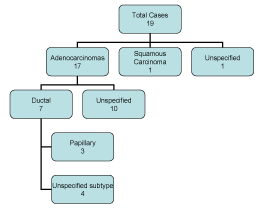 |
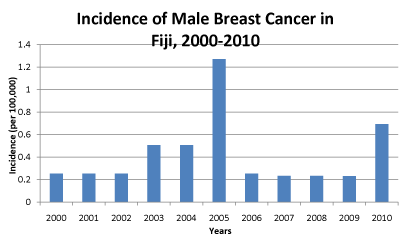 |
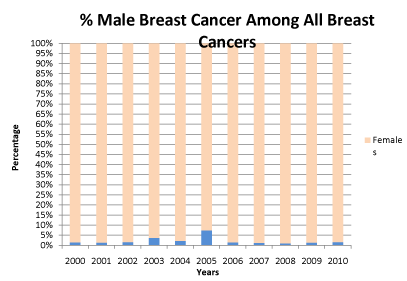 |
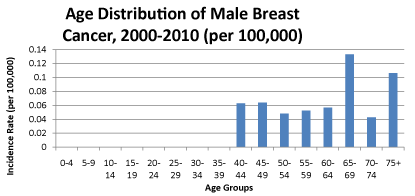 |
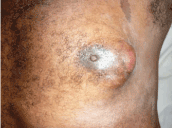 |
||||
| Figure 1 | Figure 2 | Figure 3 | Figure 4 | Figure 5 |
Relevant Topics
Recommended Journals
Article Tools
Article Usage
- Total views: 16917
- [From(publication date):
May-2012 - Nov 25, 2025] - Breakdown by view type
- HTML page views : 12284
- PDF downloads : 4633
